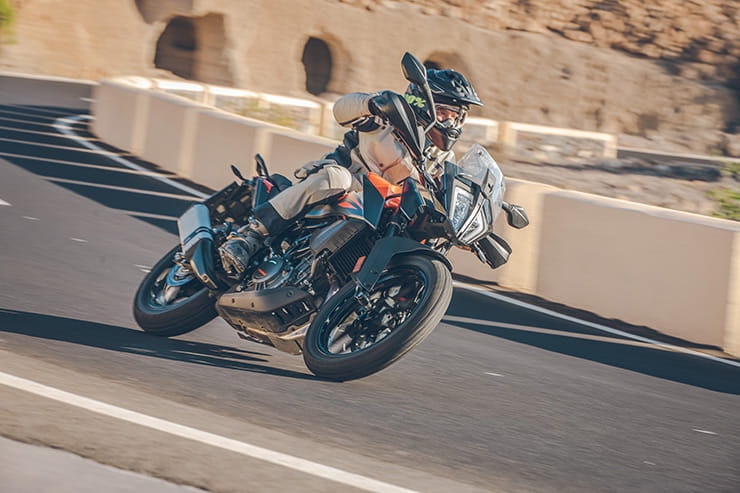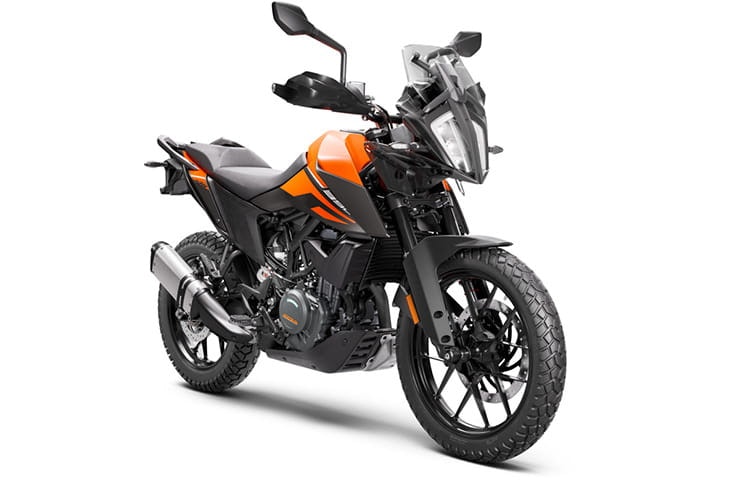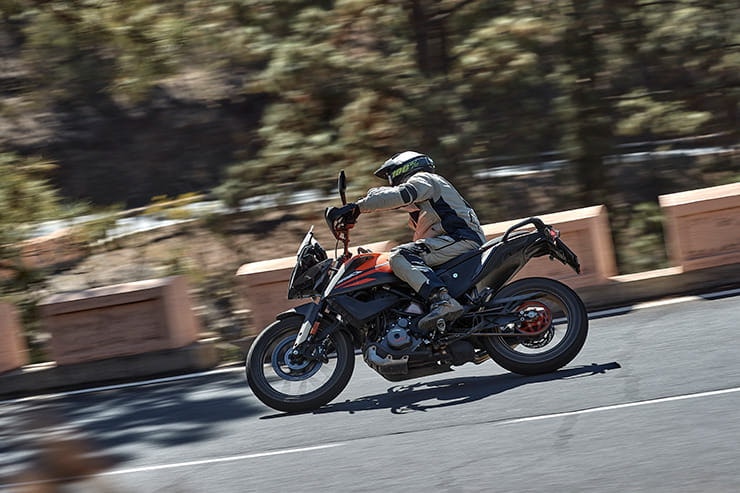KTM 390 Adventure (2020) - Review
By Paul Young
Australian former GP rider
24.03.2020
With the world in lockdown, adventure riding around the world is probably the last thing on most minds. But that’s exactly what KTM intends for their smallest accessible adventure bike to date.
Not unseasonal firestorms, biblical sandstorms, nor pandemical storm could put a stop to KTM and the local Canary Islanders going about their business. In solidarity I headed for the semi-deserted island of Tenerife for the world launch of KTM’s 390 Adventure. I’ve been looking forward to riding KTM’s miniature adventure model for some time. Hoping they, of all motorcycle companies, wouldn’t dream of diluting the enviable off-road reputation of their ‘Adventure’ brand. This is certainly a 390 Duke derivative of sorts, sharing its engine and chassis fundamentals with that most delightfully of small-capacity naked bikes on the market. But KTM haven’t just dressed the Duke up purely for Toby Price promotional purposes. And it’d be bad timing if they had, since the Dakar crown has just gone from KTM orange to HRC red for the first time since pen and paper road books. Nope, this is not a quick cash-in, dress up a 390 DUKE, this is a serious attempt to encourage soft-focus adventure riding with a new audience. But has it hit the mark?
2020 KTM 390 Adventure price
To sell its first ‘global’ adventure bike to a truly global audience it had to be as affordable as possible. Building on the 390 Duke platform makes more financial sense than building a new adventure model from the ground up, but it also carries with it some challenges and, ultimately, some compromises which could have been avoided with a clean-sheet, adventure-bike specific design. However, using a base bike significantly saves on cost, which results in a competitive, attractive price of £5499. It’s not going to break the bank balance, and is on par with its closet competition, BMW’s G310GS.
Refined suspension performance
Class leading rider aids
Punchy characterful engine
Tall seat
Hard saddle
Fiddly dash menu
Power and torque
Keeping the 373cc four-valve single on the boil requires tapping up and down the light but positive-changing six-speed gearbox, chasing the engine’s flow-zone between its 27.3ftlb peak torque at 7000rpm and 9000rpm where its power tops out at 43bhp. Although, for a more relaxed approach, rolling the throttle open from 5500rpm will provide a strong enough response to keep a reasonable pace.
Software and calibration changes to the bike’s Bosch ECU, plus the addition of a pre-cat to the also new primary catalytic convertor, were necessary to bring KTM’s 390 engine platform up to the latest emissions standards. The revised calibration strategy has softened the initial throttle connection enough to suit the Adventure’s off-road-friendly brief, without taking away too much of the engine’s trademark punchiness. This smoother throttle pick-up makes the Adventure measurably easier to keep momentum on than the RC or Duke.
2020 KTM 390 Adventure Economy/range
Long hauls are on the cards for this pint-sized traveller, too. With its Euro 5 ready engine sipping from a 14.5 litre tank at a miserly 84mpg, a potential range of around 260 - 270miles will allow for plenty of seamless saddle time should you be up for the challenge.
Engine, gearbox and exhaust
Anyone who knows the 390 Duke or RC 390 will know what a smooth and punchy little engine the long-serving 373cc liquid-cooled DOHC unit is. But it has also had its issues in the past with a snatchy throttle response and, in some circumstances, an overwhelmed cooling system. Punt the RC or Duke around inner-city traffic in high-summer temperatures and you’ll be accompanied by the whirring of radiator fan almost non-stop. My experience with the 390 Adventure tells me that, with this bike at least, both these small niggles are no longer a potential annoyance.
It’s easy to see why cooling efficiency has been radically improved. KTM developed a new curved radiator to increase its surface area without adding width, then fitted two cooling fans as opposed to the Duke’s single unit. This will be a big advantage both for commuting and for off-road riding on tight technical trails. Throttle pick up and initial turn has been improved over the 390 Duke, noticeable at slow speeds.
Handling, suspension, chassis and weight
By KTM’s own admission, the 390 Adventure is a road-focused travel bike with light off-road capabilities, not a full-blown and rugged rally-replica. I’m not sure this is what KTM at its heart would have wanted to make, given its gritty ‘Ready to Race’ ethos and reputation, but I suspect it’s the bike that accountants forced them to make.
Tenerife’s racetrack-smooth mountain roads wind up and around the island’s monolithic central volcano like a lava-strewn playground for petrol heads. Threading the little KTM between the rapid-fire apexes was like playtime. Light-footed yet surefooted, nimble yet neutral, and above all predictable and progressive. Big bike fans may ridicule, but until the road opens out leaving the hairpins far behind it’s hard to imagine a faster, more fun way to link corners together
Owning a suspension manufacturer with the expertise and quality of WP is a big benefit to KTM. This fact is highlighted with every new KTM model I ride, and again is the stand-out feature on the 390 Adventure. The WP Apex suspension may not be the brand’s top-shelf components, but they are still several levels above the 390’s competition. This is important, because the KTM really does put its closest rival, BMW’s G 310 GS, to shame in this department. And if there’s one thing a true adventure bike needs, it’s well developed high-quality suspension. This counts for both on and off-road handling, because long travel suspension without adequate damping will have you tied in knots on the tarmac, too. Riding BMW’s 310 GS at the same speed and attitude as I was able to push the KTM would’ve had the BMW bouncing and skating around like Disney on Spice. The KTM was composed and consistent, and with adjustability for rebound and compression damping in the separate-function fork legs, plus rebound and spring preload in the direct acting shock, there’s also scope for dialling in different rider weights and luggage loads.
Another example for the sometimes-unseen importance of good suspension is in a bike’s braking performance and behaviour. The KTM and GS have almost identical braking setups, yet the stopping distances and braking stability of the KTM is far superior due to its damping’s more effective control of chassis pitch and dive. The 390 also boasts cornering ABS, another first in class, with an off-road ABS mode which proved to be appropriately tuned for the loose, tricky trail conditions on Tenerife. On and off-road, I couldn’t have asked more of the ByeBre braking package, front or rear, in terms of bite, power, feel and modulation.
Continental’s proven TKC 70 dual-sport tyres provide adequate if not exceptional grip on the dirt, but have the added advantage of being a superb road-holder with confidence inspiring progression and feedback, better even than a lot of dedicated road rubber. The 130/80 17-inch rear tyre is matched to a 100/90 19-inch front, and these fairly narrow sizes help give the 390’s chassis its spritely character. Going to a 140/80, 110/90 combination would have given the 390’s wheels a greater level of off-road impact, but would have pushed the seat height even higher. It’s another decision I’m sure the development team must have mulled over at length.
Comfort over distance
The most significant challenge in using the 390 Duke as a base model is the height of the combined engine and chassis. It’s a very tall package for such a small bike. The Duke’s seat height is already on the lofty side for its class, and adding a 19-inch front wheel, high profile tyres and longer travel suspension can only push the rider in one direction. Yeah you have guessed it up.
At 174cm or nearly 5’7, I’m barely able to get a toe to ground simultaneously on both sides of the 390 Adventure. It’s not just the 855mm seat height, but also the seat’s width which adds up to this being a long straddle for an entry-level adventure tourer, or even for the lightweight urban commuter its likely to become more popular as.
For the short-arses and new riders of this world who are lacking in confidence, there is a lowering kit which reduces suspension travel by 25mm front and rear, and the seat height by the same amount. This seems barely enough to satisfy some would-be owners, and effectively matches both the travel and seat height of the 390 Duke. The kit includes a complete rear shock, internal fork spacers, plus a shorter sidestand around three hours labour cost for installation.
It seems like a missed opportunity for the 390 Adventure not to be offered as a dealer direct option in the low seat guise. This would fill a gap in the 390 range for riders put off the Duke due its aggressive attitude, and also those who want to dabble in adventure riding but are put off by the 390 Adventure’s saddle height. Interestingly, in some Asian markets such as the Philippines the lowered suspension version comes factory fitted as that market’s standard model. So it seems a no-brainer to offer it everywhere else, too.
Of course, once rolling, saddle height doesn’t come into the equation, so ‘how does it ride?’. On the road, the 390 Adventure offers all the joyous giggles and fun of the 390 Duke, but with the added comfort and surety of being sensibly seated, with user-friendly ergonomics. As opposed to being perched on an uncomfortable bar stool with a set of handlebars thrust into your groin, as per the Duke’s 390. Ignore the Adventure badges, and this could just be the 390 Duke’s likable alter ego, more suited to life’s daily-duties and much kinder to less-than-limber limbs.
It wasn’t until 30miles into the ride that I became conscious of any vibration. This came primarily through the large, grippy off-road style steel footpegs, which strangely are steeply angled forward. The ’pegs had their vibe-damping rubber infills removed for our test ride, so this shouldn’t be a concern with the rubbers fitted. Vibrations via the bars is minimal for a rev-happy single-cylinder motor, and the seat is similarly isolated from the vibes’ too.
That seat, though, is not quite up to the all-day comfort I’d hope from an all-day bike. It is firm, for sure, but I think it’s more its lack of form which effects comfort. If bums were shaped like ironing boards, it might work, but bums tend to be more rounded than that.
Rider aids and extra equipment / accessories
The KTM’s principle selling point is the addition of traction control on a bike of this size for the first time. Not just any old traction control, but lean angle sensitive traction control. The system has just one setting, plus the option to disable TC altogether. This can be done on the fly, but because of the amount of button prodding faff involved, plus the fact you have to keep the throttle closed and buttons prodded for an eternity while it resets, and also considering the attention you really should be spending on the road ahead, it’s not an advisable practise. Best just to stop at the start of the dirty bits to switch it off. And you will want to switch it off if the going is loose or steep. The MTC’s calibration is very much a safety feature for less experienced riders and slippery tarmac. Try to tackle a loose gravelly climb with it on and you will struggle to keep momentum. For the road, though, the 390’s MTC is a useful safety net for learners. Experienced riders will probably want to turn it off when hitting dry open roads, and especially for scratching hairpins in the mountains, something the 390 Adventure excels at. My experience and suspicion tells me that the lean angle sensitive part of the MTC cares little for whether there is actually any loss of traction, and simply always reduces power output via the ride-by-wire throttle when the bike is leaned over, regardless of how much grip is available. Although this is a valid and effective way of protecting novices from getting ham-fisted at big lean angles - a phenomena that as a race school instructor I’ve been terrified by time and again - it does detract from the fun of reading the road by brail and belting it out of second gear hairpins. However, with the ‘off’ option, that’s not a problem.
Thumbing through the settings menu via the lefthand switch cube is a relatively easy and intuitive task, with the options all displayed on the large TFT dash in a clear, bold fashion so even tired old eyes can understand it at a glance and in full sun glare. That enormous tablet-like dash looks much more at home on the 390 Adventure than it does on the Duke. The compact yet effective rally-style fairing and screen absorbs the beefy display unit visually, as opposed to it being a slightly preposterous bump on the naked 390.
Let’s go off-road
Immaturely I managed to leave the ‘fast’ group mostly eating dust, hitting everything at full tilt and gleefully launching off every lip I spotted, yet still managed to return with my bike unscathed, unlike one who managed to puncture a tyre. Maybe it was the extra five clicks of compression damping I dialled into the fork, maybe it was catlike reaction line choices and unworldly finesse (ok just luck). But, even so, if I were planning a life of trail torture for my own 390, the first KTM Powerparts accessory on the shopping list would be the spoked wheel set, swiftly followed by a set of TKC 80s and heavy-duty tubes.
As well as the non-slip security of aggressively serrated foot pegs, the 390’s adventure-ready cred is bolstered by a folding gear lever tip, replaceable serrated toe piece on the rear brake lever, and span adjustability on both the front brake and clutch levers. There’s also a GPS mounting point front and centre above the dash, perfectly placed.
Rivals
2020 KTM 390 Adventure Verdict
Sure, there’s been some compromise for the cost savings of developing on the same platform as the 390 Duke. But it’s made up for by thoughtful detailing and some technology currently only available in the orange camp. KTM’s ‘global’ adventure bike may not be perfect, but it is the most capable, best equipped, highest quality, and most engaging motorcycle in its class, and by some distance. Something tells me that the lightweight adventure bike market is just getting warmed up, and I can’t wait to see some new protagonists break cover in the coming years. Go light, go long, less weight, more adventure!
2020 KTM 390 Adventure Spec
Looking for bike insurance? Get a quote for this motorcycle with Bennetts motorbike insurance


